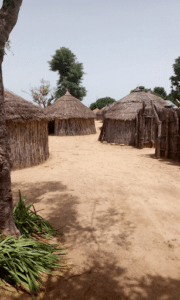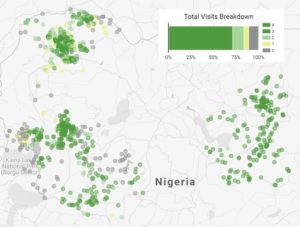Providing healthcare to the most rural and vulnerable populations around the globe has always been a challenge.

A settlement identified in Bauchi, Nigeria by a Premise contributor.
Polio eradication has taken decades, and malaria and tuberculosis continue to afflict primarily the poor and vulnerable despite enormous efforts. Today, with the rampant COVID-19 viral pandemic entering its fourteenth month and several approved vaccines to prevent it being distributed, our international organizations, national and local governments need to cooperate—and hustle. However, distributing the COVID-19 vaccine as quickly as possible should not come at the cost of equity and inclusivity.
That’s why digital microplanning is the approach that has been adopted by global health leaders including the World Health Organization (WHO), UNICEF and Gavi, the Vaccine Alliance.
Microplanning consists of highly detailed, district-level plans which provide clear direction to field agents and enable precise monitoring to ensure services reach target populations, no matter their proximity to established medical care. Geographic information systems (GIS) satellite data enables the identification of new or informal human settlements in order to bring them into vaccine outreach plans. This is particularly important in countries where maps are outdated or incomplete.
Premise has helped clients measure coverage for routine immunizations, and today we are preparing to assist COVAX countries strengthen their national COVID-19 vaccination plans. Critical to digital microplans, the Premise platform enables clients to validate the names and locations of new and informal settlements as well as establish up-to-date datasets on existing health facilities, including details about available cold chain equipment, exact coordinates, and hours of service.

All the settlements identified by Premise contributors in the Nigerian states of Bauchi, Niger and Sokoto.
In West Africa, the Bill and Melinda Gates Foundation and GRID3 (Geo-Referenced Infrastructure and Demographic Data for Development) utilized satellite imagery to collect and analyze geospatial settlement data to create a comprehensive map layer to aid in polio immunization microplanning efforts. Grid3 used the Premise platform to validate the names of newly identified settlements in the Nigerian states of Bauchi, Niger and Sokoto.
Premise contributors are on the ground in these regions. Contributors will physically visit those locations and learn the names of the settlements. This provides a level of quality assurance and allows them to record possible alternate names. Similarly, contributors visited each health facility multiple times and a subsequent harmonization process was used to clean and merge the data.
Some of the key results from Premise’s work with GRID3 include:
- A total of 824 settlements, approximately 90% of all unknown settlements, were visited and named by Premise contributors.
- 35 health facilities were located in unknown settlements and 42 settlements were found to be uninhabited.
- Quality photos of the settlements provided on-the-ground context for planning and delivery of services.
- GRID3 has delivered the data to the Nigerian National Space Research and Development Agency to support other health-related and development interventions through microplanning.
Understanding barriers to vaccination, hesitancy and misinformation is another element critical to microplanning. Through sentiment surveys and online tasks that ask contributors to document content found in private social media and texting apps, Premise can help clients understand local problems and sources of information and influence. Armed with that knowledge, our clients can plan and implement corrective solutions.
The international development community has long recognized microplanning as an essential tool for the equitable distribution of services. Even though speed is crucial as we race toward post-pandemic normalcy, providing the vaccine to the people who are the most difficult to reach—those in very rural or conflict-affected areas, or in informal settlements—needs to be a priority. With microplanning, vaccination campaigns can carefully consider and plan how to reach those populations.
Want to learn more? Get in touch with us today.